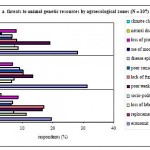DAD-Net, which is hosted by the Animal Genetic Resources Group of FAO, is organizing an e-conference “Analysing threats to domestic animal genetic resources.” It will run 4-25 May and…
…[i]nput from the e-conference will be used to fine tune and finalize a document that will be circulated via DAD-Net, and potentially made available to the Commission on Genetic Resources for Food and Agriculture.
A background document has been circulated and will form the basis of the discussion. It consists of a summary of responses from 107 subscribers from 55 countries to a questionnaire survey to identify threats to animal genetic resources. The headline finding is that by far the main danger to animal genetic resources worldwide are “economic and market driven threats.” Click on the thumbnail below to see the breakdown by agro-ecological zone.

You know, I don’t recall a similar e-conference ever happening for crops. Why not, I wonder? These animal people are so much more Web 2.0. Anyway, I look forward to blogging about the main findings of the discussion when they come out.